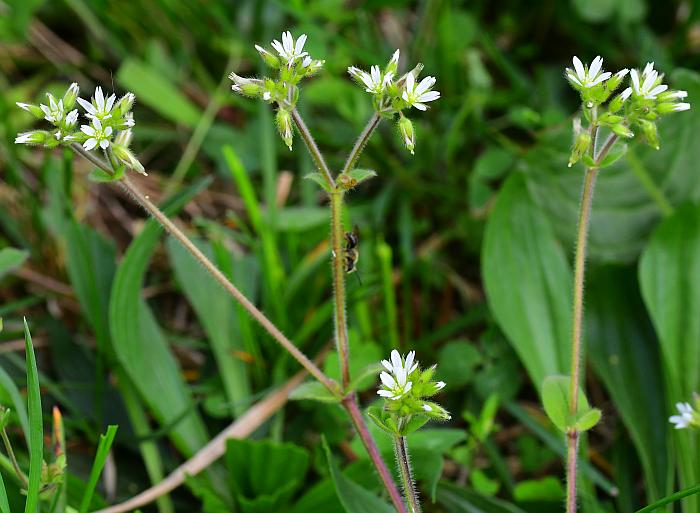Cerastium glomeratum Thuill.
Clammy Chickweed

Introduced
CC = *
CW = 5
MOC = 35
© SRTurner
Cerastium glomeratum Thuill.Clammy Chickweed | |
 |
Introduced CC = * CW = 5 MOC = 35 |
© SRTurner |
|
Family - Caryophyllaceae Habit - Annual forb. Stems - Ascending to erect, to 30 cm, multiple from fibrous roots, sometimes branched, densely pubescent with glandular (especially toward the tip) and nonglandular hairs.
Leaves - Opposite, simple, entire, sessile, 0.5-3.0 cm long, spatulate (some basal leaves) or elliptic to narrowly oblong-obovate, abruptly short-tapered to a minute, sharp point at the tip, pubescent, with prominent midrib below.
Inflorescence - Dense, crowded terminal clusters or small panicles. Pedicels 1-3 mm long, 0.5-1.0 times as long as sepals, densely glandular-pubescent, usually longest in the first-opening flowers, erect to spreading at flowering and fruiting, 0.6 mm in diameter, elongating slightly in fruit. Bracts with herbaceous, green margins.
Flowers - Sepals 5, 3-5 mm long, lanceolate, green or occasionally reddish-tinged at the tip, angled or tapered to a sharply pointed tip, moderately to densely pubescent with glandular and nonglandular hairs, these extending past and somewhat obscuring the sepal tips. Petals 5 (rarely absent), 3-5 mm long, 0.7-1.2 times as long as the sepals, shallowly 2-lobed at the tip (to about 1/3 the total length), the veins usually not apparent, white, glabrous. Stamens 10. Filaments 3mm long, white, glabrous. Anthers whitish, 0.2 mm long, 3-lobed. Ovary sub-globose, green, glabrous, 1.5-2 mm long, with many ovules, placentation axile. Styles 5, white, 1.5 mm long.
Fruits - Cylindrical capsules 5.0-9.0 mm long, 1-2 times as long as the sepals, slightly curved. Seeds 0.5-0.6 mm wide, the surface tuberculate, brown.
Flowering - March - July. Habitat - Fields, pastures, prairies, lawns, open woods, roadsides, railroads. Origin - Native to Europe. Lookalikes - Several other species of Cerastium, and to a lesser extent, Stellaria. Differentiation requires attention to fine details. Other info. - This common but often overlooked species is found in Missouri mostly south of the Missouri River. In the continental U.S. it occurs throughout most of the eastern half of the country and also the Pacific coastal states, but it apparently rare to absent in much of the Great Plains and mountain states. Many of the species of Cerastium appear very similar, and a confident determination requires experience and close attention to minute detail. One feature which sets this species apart from several others in the genus is its crowded inflorescences. The flowers are on very short stalks, with several often appearing in a tight bunch. Photograph taken in Brown Summit, NC., 4-6-03 (DETenaglia); also at Weldon Spring Conservation Area, St. Charles County, MO, 4-21-2008, near Labadie, Franklin County, MO, 4-6-2020 and 4-14-2023, and Riverfront Park, Washington, Franklin County, MO, 4-7-2021 (SRTurner). |